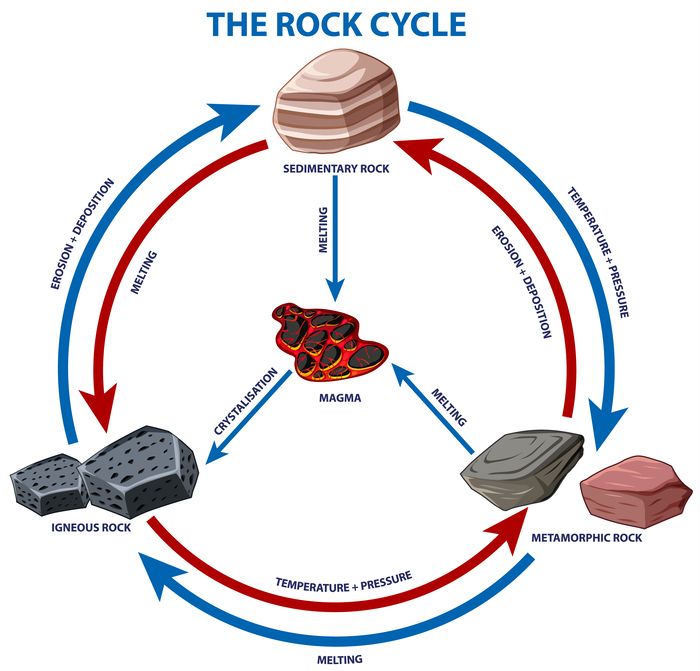Types of Rocks - Sedimentary, Igneous and Metamorphic | Rock Formation | Rock Cycle
In the given article, we have discussed the various types of rocks of earth, how they are formed, their characteristics and further classification so that one can understand other related concepts well.
1. Classification of Rocks of Earth:
The material of the crust of the earth is generally called rock. They can be of different colours, sizes and textures.
The rocks are classified based on their origin. The types of rocks are mentioned below:
1. Sedimentary Rocks
2. Metamorphic Rocks
3. Igneous Rocks
1.1 Sedimentary Rocks:
They are formed by the sediment and debris accumulated over long periods. The sediments are derived from the older rocks, plants and animals. Geological processes that lead to the formation of sedimentary rocks are erosion, weathering, dissolution, precipitation and lithification. Ganga-Brahmaputra delta is a good example of sedimentary accumulation.
These rocks have layered structures therefore they are also known as stratified rocks. Sometimes, layers are not present in sedimentary rocks like loess. The Himalayas are made up of sedimentary rocks. Sandstone, Conglomerate, limestone, shale, are examples of sedimentary rocks.
Types of Sedimentary Rocks:
Sedimentary rocks are classified based on the nature of sediments as:
- Mechanically Formed Sedimentary Rocks/ Clastic Sedimentary Rocks: These are formed from the mechanical weathering of rocks. They are generally made up of sand grains. Sandstone, conglomerate, limestone, shale and loess are some examples of mechanically formed sedimentary rocks.
- Organically Formed Sedimentary Rocks: These are formed by the remains of living organisms. Limestone, chalk and coal are some examples of organically formed sedimentary rocks.
- Chemically Formed Sedimentary Rocks: These are formed by the chemical materials present in the running water. Gypsum, Salt rock, Dolomites, Coals are some examples of chemically formed sedimentary rocks.
On the basis of transporting agents, it is classified into (1) Argillaceous rocks i.e. Marine rocks, Lacustrine rocks and Riverine rocks, (2) Aeolian Sedimentary Rocks i.e. Loess and (3) Glacial Sedimentary Rocks i.e. Till and Moraines.
1.2 Metamorphic Rocks:
They are formed under the influence of heat or pressure on sedimentary or igneous rocks. Heat and pressure change the colour, hardness, structure, and composition of the pre-existing rocks. Heat, Compression and Solution (Chemically active hot gases and water) are the agents of metamorphism. The examples of metamorphic rocks are as follows:
|
Rocks |
Metamorphic rocks |
|
Granite |
Gneiss |
|
Basalt |
Amphibolite |
|
Limestone |
Marble |
|
Shale |
Slate |
|
Sandstone |
Quartzite |
Types of Metamorphic Rocks:
The metamorphic rocks can be further classified into: Foliated (layered) and Non-foliated (non-layered). Gneiss and Phyllite are examples of foliated rocks. Marble and Quartzite are examples of non-foliated one.
1.3 Igneous Rocks:
Igneous rocks are formed by the cooling and solidification of molten rock from beneath the earth’s crust. Igneous rocks are crystalline in structure and don’t contain fossils. Igneous rocks are found both in the Himalayas and the Deccan Plateau. They are known as the primary rocks of the earth. They are also called parent rocks because all the subsequent rocks were formed directly or indirectly from the igneous rocks. Minerals of economic importance are found in igneous rocks.
Types of Igneous Rocks:
Igneous rocks can be classified as:
- Extrusive Rocks: They are formed by the cooling of lava on the earth’s surface. They are also known as volcanic rocks. The lava cools very quickly. These rocks have fine-grained texture and small or no crystals. Gabbro and basalt are examples of extrusive rocks. Deccan plateau is made up of extrusive igneous rocks.
- Intrusive Rocks: They are formed when magma solidifies below the earth’s surface. The magma cools very slowly. These rocks have coarse-grained texture and large crystals. Granite and dolerite are common examples of intrusive rocks.
Igneous rocks can be also classified into acidic and basic rocks:
- Acidic Igneous Rocks: These are composed of Silica. These rocks are light coloured, hard, and very strong. Granite is an acidic igneous rock.
- Basic Igneous Rocks: These rocks are dark coloured and weak for weathering. Gabbro, basalt, and dolerite are examples of Basic igneous rocks.
2. Rock cycle:
What is Rock Cycle?
The process of transformation of one rock into another is called the rock cycle. Igneous and metamorphic rocks get broken into smaller particles and deposited to form sedimentary rocks. Igneous and sedimentary rocks under immense heat and pressure transform into metamorphic rocks. Metamorphic and sedimentary rocks under great heat and pressure meltdown to form magma and solidify again to form igneous rocks.

Fig. 1: Rock Cycle
3. Summary
Sedimentary Rocks: also called stratified rocks due to layered structure, examples: Sandstone, Conglomerate, limestone, shale
Metamorphic Rocks: formed under the influence of heat or pressure, examples: Gneiss, Marble, Slate, Quartzite
Igneous Rocks: crystalline in structure, formed by the cooling and solidification of molten rock, extrusive rocks (Gabbro, basalt) and intrusive rocks (Granite, dolerite)
Rock Cycle: Transformation of one rock into another
Need to know Facts:
- The eight most abundant elements of the whole earth are: Iron, Oxygen, Silicon, Magnesium, Nickel, Sulphur, Calcium, Ammonium (In Decreasing order)
- The eight most abundant elements of the earth’s crust are: Oxygen, Silicon, Aluminium, Iron, Magnesium, Calcium, Potassium, Sodium (In Decreasing order)
- The sedimentary rocks cover around 75% of the area of the globe but constitute only 5% of the composition of crust.




 Latest
Latest 



Comments